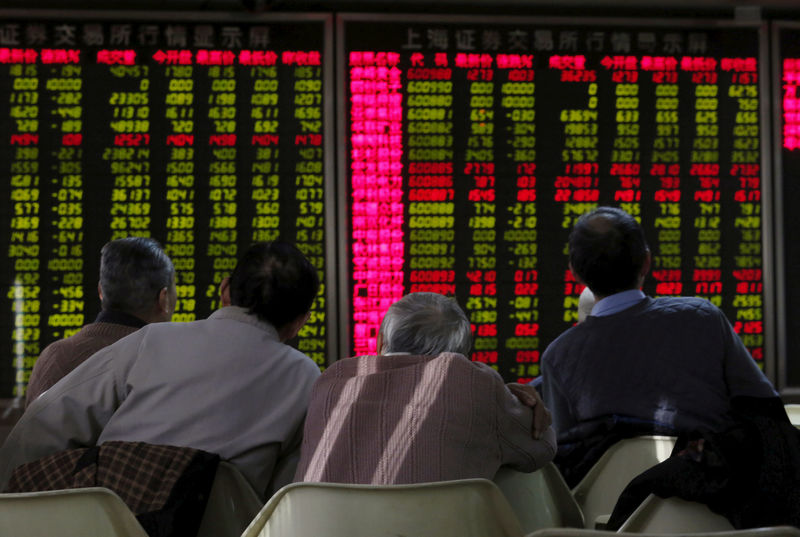 © Reuters. FILE PHOTO: Men look at an electronic board showing stock information at a brokerage house in Beijing
© Reuters. FILE PHOTO: Men look at an electronic board showing stock information at a brokerage house in BeijingBy Andrew Galbraith and Winni Zhou
SHANGHAI (Reuters) – China’s stock markets sank on Wednesday as the U.S. said it would slap tariffs on more Chinese goods before month end, overshadowing Beijing’s pledges to spur growth and cushion the economy from what is shaping up to be a protracted trade war.
The Shanghai Composite index () fell 0.3 percent, and the blue-chip CSI300 index () was 0.6 percent lower.
Both indexes posted their biggest daily gains since 2016 on Tuesday, rebounding from four days of heavy losses and raising hopes that their dizzying trade-induced slide into correction territory may be easing up.
Stocks remained in the red despite stronger-than-expected July export data which appeared to show that an earlier round of U.S. tariffs has yet to have a significant impact on global demand for China’s goods.
In Hong Kong, the Hang Seng index () gained 0.3 percent and the China Enterprises index () was up 0.5 percent.
Attention in Hong Kong was on the market debut of China Tower Corp Ltd (HK:), the world’s largest initial public offering in two years. The company’s shares were little changed as trade war fears weighed on sentiment.
Chinese stock markets are highly sensitive to changes in liquidity and have generally been quick to respond to even vague pledges of government pump priming in the past.
But the flurry of punitive trade blows from the Trump administration and little sign of compromise from either side has left many investors doubtful of a sustained turnaround for shares in the near term.
“China’s monetary and fiscal policies have shifted from prudent to growth supportive. The ongoing and protracted trade tension has elevated uncertainties which prompted more concerns over downside risks to growth,” Christy Tan, head of markets strategy and research, Asia, at National Australia Bank, said in a note.
Earlier on Wednesday, the U.S. said it will begin collecting 25 percent tariffs on another $16 billion in Chinese goods from Aug. 23, and Chinese media have resorted to personal attacks against President Donald Trump.
The measures come after Washington slapped tariffs on $34 billion of Chinese goods last month.
Escalation in the Sino-U.S. trade war has threatened to put more pressure on the already cooling Chinese economy, and has prompted a series of growth boosting measures from Beijing.
Last week, a top decision-making body of the ruling Communist Party promised more flexible and effective policy to boost growth, and authorities are taking steps to offer more credit at cheaper interest rates to small and medium-sized firms which are seen as most vulnerable.
The plans appear to be offering respite for some investment-intensive companies that were badly mauled in the broad based market selloff in recent weeks.
Shares in China Railway Construction Corp Ltd (SS:) rose 0.6 percent on Wednesday, a day after jumping the daily 10 percent limit on news that China would boost its fixed asset investment in railways to 800 billion yuan ($116.85 billion) in 2018, an increase of 9.3 percent over its original plan.
Beijing is also taking steps to ease financing constraints on borrowers, which have been fueled in part by a multi-year campaign to reduce excessive financial risks and slow a rapid build-up in debt.
On Wednesday, the state planner said that China would use monetary policy such as targeted cuts in the reserve requirement ratio (RRR) for banks to support debt-to-equity swaps this year as it looks to lower corporate leverage ratios.
STRONGER YUAN
While China’s stock markets remain fragile, there are hopes among global investors that Beijing is moving to stabilize the yuan currency.
After allowing the yuan to fall for eight straight weeks against the U.S. dollar, triggering global fears China may be embarking on a “stealth devaluation”, there are signs that authorities are now attempting to put a floor under the currency and discourage bets on further losses that could trigger capital outflows.
The yuan strengthened on Wednesday, as the central bank guided the currency higher with its daily fixing. The upbeat trade data appeared to have little impact.
A Bloomberg report, citing unnamed sources, said that China’s central bank on Monday urged some banks to prevent “herd behavior” and momentum-chasing moves in the foreign-exchange market.
On Wednesday, the People’s Bank of China (PBOC) set the midpoint of the yuan’s daily trading band
The currency opened at 6.8140 per dollar on the spot market
The central bank set a reserve requirement ratio of 20 percent from Monday for financial institutions settling foreign exchange forward dollar sales to clients, effectively raising the cost for investors shorting the yuan.
While many analysts still expect the currency to test the level of 7 to the U.S. dollar, Ken Hu, chief investment officer for Asia Pacific fixed income at Invesco in Hong Kong said he maintained a more positive outlook in the longer term.
“We see limited depreciation pressure on the in the near future and are confident that Chinese regulatory authorities have sufficient tools to manage any exaggerated one-way market move,” he said in a note.
“We believe that strong domestic demand in China provides enough buffer to counter potential impact from rising trade tariffs,” he added.
Source: Investing.com


























